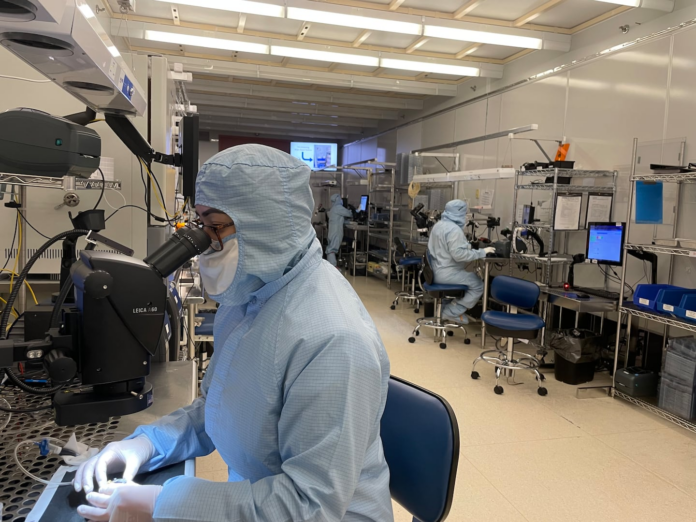But Westborough-based Kopin thinks it’s leapfrogged foreign rivals with a new kind of miniature video display that delivers clearer images than anything now available. In addition, Kopin’s developing a version that uses light reflected from the user’s eyes to constantly adjust the brightness of the image, so soldiers in combat will never be blinded by glare or left to grope in the dark.
The US Army recently awarded $15.4 million to fund Kopin’s development of a full-color version of the display. If the company’s successful in perfecting its system, it could mean hundreds of millions in new military sales, and perhaps an opportunity to develop a version for civilian markets.
Founded in 1984 as a spinoff from the Massachusetts Institute of Technology, Kopin began life as a semiconductor company. Its founder John Fan invented a type of transistor that enabled the development of smaller, lighter wireless phones.
More recently the company has specialized in small video displays for augmented reality headsets. Despite growing demand for such systems, Kopin has struggled to compete against rivals in China, South Korea and Japan.
In its 2024 annual report, Kopin said that it’s posted $402 million in net losses since its founding. The report warned that “there is substantial doubt about our ability to continue as a going concern” unless Kopin finds a way to achieve consistent profitability.
Since the report was issued in April, the clouds have lifted a little. In August the company received a $15 million investment from Theon Group, a Cyprus-based maker of thermal imaging equipment. Theon is also one of several companies that in September agreed to invest an additional $41 million in Kopin. Murray now says “we are a going concern once again and have no doubt we have enough cash to continue operations for many years.”
For years, Kopin’s video screens have relied on liquid crystals or organic light emitting diodes. Now comes a promising alternative called MicroLED, which generates images many times brighter. So far nobody’s making large MicroLED screens for TVs or computer monitors, but companies in Europe, the US and China are working hard on bringing them to market.
“The benefit of MicroLED would be very high brightness, very good contrast and image quality, potentially lower power consumption. so longer battery life,” said Eric Virey, senior microdisplay analyst at Yole Group in Portland. They’re also tough, making them ideal for military applications, he said. But Virey also said that the only company presently shipping MicroLED screens is Chinese manufacturer JBD.
Kopin recently showed off one of its MicroLED prototypes, a monochrome version that was painfully bright to look at, even at 10 percent power. Turned up all the way, said Murray, “that will peel the retina out of your eye.”
Then what good is it? Murray said that much of the light energy is absorbed by the waveguides that transmit the image to the user’s eyes. By starting with a super-bright MicroLED image, the optical system will always deliver sharp images.
Separately. Kopin is developing NeuralDisplay, a technology that adds sensors to the video screen that pick up the light reflected by the user’s eyes. An artificial intelligence system uses this reflected light to track the pupils of the eyes, and estimate whether they’re receiving too much or too little light. A soldier stepping from bright sunlight into a dark room would not have to wait for his eyes to adjust. Within 500 microseconds, Murray said, the system adjusts to deliver the right amount of light.
A video display that keeps an eye on the user? “That’s possible,” said video display expert William Wong, professor of electrical and computer engineering at the University of Waterloo. “Silicon makes an excellent light detector,” he said, and a sufficiently clever algorithm could use the detected light to measure the user’s pupils and adjust the light intensity.
Paul Travers, chief executive of Vuzix, a Rochester NY maker of smart glasses, now uses low-cost MicroLED displays made in Asia, though Travers won’t say which country. He said the technology being developed by Kopin will be far superior.
“We hope they’re incredibly successful,” said Travers. “I think it’s going to take over as the display technology of choice for smart glasses.”
Now it’s up to Kopin to perfect the new system. If the company comes through, Murray believes Kopin will be in position for a deal to provide displays for the Army’s Soldier Borne Mission Command program, a $22 billion effort to provide soldiers with advanced wearable computers with augmented reality optics.
An earlier effort based on Microsoft’s HoloLens AR headset came to nothing, as soldiers said the bulky headwear caused motion sickness and headaches. Murray said this was partly because the Microsoft helmet was bulked up with multiple cameras to track the user’s eye movements.
When Kopin combines its MicroLED screens with the NeuralDisplay technology, the video screen itself could handle the eye tracking, so headsets could be smaller, lighter and more energy-efficient.
During a September conference call with financial analysts, Murphy said that he expects the Army to order up to 120,000 vision systems. If Kopin is tapped to provide the screens, it could generate up to $500 million in revenue over the life of the program, the kind of cash that could put Kopin firmly in the black.
Display maker Kopin claims breakthrough in microdisplays
RELATED ARTICLES



